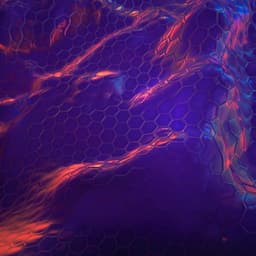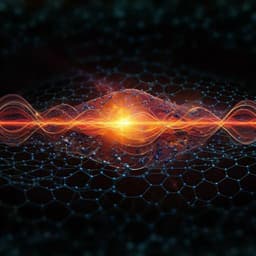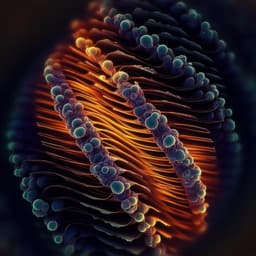
Physics
Spontaneous time-reversal symmetry breaking in twisted double bilayer graphene
M. Kuiri, C. Coleman, et al.
Delve into the fascinating world of twisted double bilayer graphene (tDBG), where an anomalous Hall effect and spontaneous time-reversal symmetry breaking reveal insights into valley ferromagnetism. This groundbreaking research conducted by Manabendra Kuiri and colleagues explores the intricate coupling of spin and valley properties within a correlated metallic state.
~3 min • Beginner • English
Introduction
Flat electronic bands in moiré van der Waals heterostructures provide a platform where Coulomb interactions and non-trivial band topology intertwine, yielding correlated and topological phases. Graphene-based systems are particularly versatile because Dirac points near the Fermi level offer a natural resource for band topology, and flat bands can be engineered and tuned by gate voltages and magnetic fields. Twisted double bilayer graphene (tDBG), comprising two AB-stacked bilayers twisted by ~1.3°, is uniquely tunable: top and back gates control both carrier density n and vertical displacement field D, thereby adjusting band flatness and topology. Prior studies reported metallic states with broken spin and valley symmetries and correlated insulators near certain fillings, but the nature of the order parameters and associated topology remained unresolved. The present work asks whether correlated metallic states near full filling of the first moiré conduction band in tDBG spontaneously break time-reversal symmetry, and if so, whether the underlying ferromagnetism is associated primarily with spin or valley polarization. Establishing the symmetry breaking, its magnetic anisotropy, and its dependence on band structure tuning (via D and filling ν) is crucial for understanding interaction-driven topological transport in this system.
Literature Review
The interplay of topology and correlations in moiré flat bands has led to correlated insulators, unconventional superconductivity, and Chern insulating phases (refs. 1–5, 11–13). Anomalous Hall effects arising from broken time-reversal symmetry have been observed in twisted bilayer graphene aligned to hBN and in Bernal-stacked bilayer graphene (refs. 15–17, 31–33). tDBG offers gate-tunable flat and topological bands (refs. 9, 10, 18), and correlated insulating states and spin-polarized phases have been reported (refs. 19–24, 28, 35). Theoretical works predict quantum valley Hall effects, orbital magnetism, and AHE in twisted multilayer graphene (ref. 20), and Hartree-Fock treatments highlight interaction-driven band renormalization and Berry curvature features relevant for AHE. However, direct evidence of spontaneous time-reversal symmetry breaking and clarification of spin versus valley ferromagnetism in tDBG’s correlated metallic states remained open. Prior angle-dependent AHE studies in TBG aligned to hBN indicated sensitivity predominantly to out-of-plane fields, consistent with valley polarization (ref. 33).
Methodology
Devices: High-quality AB–AB stacked tDBG devices were fabricated using a modified tear-and-stack technique. A large bilayer graphene flake was mechanically split and sequentially picked up with a PC/PDMS stamp, forming two AB bilayers twisted by ~1.36°. The heterostructure was encapsulated between hBN layers with a graphite bottom gate; a metal top gate was deposited to independently control carrier density n and displacement field D. Edge contacts were formed by etching and Cr/Au deposition. Devices were patterned into Hall bars. Two devices were studied: D1 (θ ≈ 1.31°) and D2 (θ ≈ 1.34°), with twist angles extracted from the carrier density at full filling of the first moiré conduction band (ν = ±4). Measurement setup: Four-terminal transport was measured using lock-in techniques (13.3 Hz, 1 nA) in a dilution refrigerator (mixing chamber 10–15 mK; effective sample temperature 50–200 mK during sweeps) equipped with a 3-axis vector magnet enabling independent control of in-plane (B∥) and out-of-plane (B⊥) fields. Longitudinal and Hall resistances were processed to obtain field-symmetrized ρxx and antisymmetrized ρxy; B⊥ values were corrected for flux trapping in the superconducting magnet. Gate control: n and D were independently tuned using top and bottom gates with n = (CbgVbg + CtgVtg)/e and D = (CbgVbg − CtgVtg)/(2ε0). Parameter space mapping: ρxx(n, D) maps identified correlated insulating states and surrounding ‘halo’ metallic regions of enhanced resistance. Magnetic-field sweeps: For selected (ν, D) within and outside halos, ρxx(B⊥) and ρxy(B⊥) were measured with bidirectional sweeps to detect hysteresis. Angle dependence was probed by sweeping B⊥ at fixed B∥ up to several Tesla, and by sweeping B∥ at fixed B⊥ = 0 to study in-plane magnetoresistance. Temperature dependence: Hysteresis loops and zero-field R(T) were measured up to several Kelvin to determine the temperature scale for symmetry breaking. Bandstructure calculations: Single-particle and self-consistent Hartree(-Fock) calculations were used to model the moiré band dispersion and Berry curvature under experimental parameters, highlighting interaction-driven band flattening and the distribution of Berry curvature in the first conduction band.
Key Findings
- Observation of anomalous Hall effect (AHE) with hysteresis: In the correlated metallic ‘halo’ regions near full filling of the first moiré conduction band (ν ≲ 4), ρxy(B⊥) and ρxx(B⊥) exhibit clear hysteresis loops indicative of spontaneous time-reversal symmetry breaking and ferromagnetism. Coercive fields are typically ~0.3 T, with loops persisting across multiple scans. AHE is observed for both signs of D, though hysteresis is less pronounced at positive D. - Doping and displacement-field dependence: Robust AHE hysteresis appears for 3.5 ≤ ν ≤ 3.7 with nearly constant coercive field and large loop height; hysteresis collapses below ν ≈ 3.4. Near and beyond the single-particle insulator at ν > 3.75, multiple switching events indicate multi-domain behavior. The AHE is nearly independent of D within the halo (e.g., −0.40 V/nm ≥ D ≥ −0.46 V/nm at ν = 3.6), but absent outside the halo. - Magnetic anisotropy suggests valley ferromagnetism: AHE hysteresis in B⊥ remains robust even when a large in-plane field is applied: hysteresis loops persist for fixed B∥ up to 5 T (D2) and above ~1 T (D1), with only small changes (e.g., small B∥ hysteresis ~50 mT in D2). This weak sensitivity to B∥, contrasted with strong dependence on B⊥, points to an orbital (valley) origin of the ferromagnetism. - Unusual in-plane magnetoresistance within AHE region: Sweeping B∥ at B⊥ = 0 reveals a sharp negative magnetoresistance peak centered at B∥ = 0 that appears immediately upon entering the AHE regime (ν ≥ 3.4) and grows with ν. The peak is rounded on an exceptionally small field scale (~1 mT at 100 mK), far smaller than expected from Zeeman energy kBT/(gμB) (~100 mT at 100 mK for g = 2), suggesting spin–valley coupling or direct weak orbital coupling of B∥ to valley order due to finite thickness. The detailed B∥ magnetoresistance lacks reproducibility and is non-hysteretic, unlike the robust B⊥ hysteresis. - Temperature scale: AHE hysteresis persists up to about 1.8 K (D2; similar in D1), with coercive fields shrinking as temperature increases. Away from the AHE region (e.g., ν < 3.2), Rxx(T) shows a step-like increase around ~7 K, consistent with temperature-induced collapse of symmetry-broken states in the broader halo. The evolution with ν suggests a correlated low-T ground state with coupled spin and valley order. - Bandstructure and Berry curvature: Self-consistent Hartree(-Fock) calculations for θ ≈ 1.3° and D ≈ 0.44 V/nm show a nearly flat, isolated first conduction moiré band with significant Berry curvature concentrated near kxky ≈ 0, consistent with stronger AHE signals as the highest-energy (last-filled) states are occupied (ν ≳ 3.4). - Device and mapping context: ρxx(n, D) maps show insulating stripes at n = 0 (gap between conduction and valence bands at finite D) and at full filling (ν = 4; n ≈ 4.0–4.2 × 10^12 cm^−2), enabling twist-angle extraction (θ ≈ 1.31° in D1; θ ≈ 1.34° in D2). Strong correlated insulating states are observed at ν = 2 and ν = 3 (the latter even at B = 0), with surrounding halo regions of enhanced resistance where the AHE ferromagnetic metal appears near ν → 4.
Discussion
The observed hysteretic AHE establishes spontaneous time-reversal symmetry breaking in tDBG’s correlated metallic state near full filling of the first moiré band. The pronounced magnetic anisotropy—strong sensitivity to B⊥ with hysteresis persisting in the presence of large B∥—supports an orbital (valley) ferromagnetic origin rather than a purely spin ferromagnetism, consistent with weak spin–orbit coupling in graphene and with prior angle-dependent AHE studies in TBG aligned to hBN. The doping dependence links the onset and strength of AHE to the population of high-Berry-curvature states near the top of the conduction moiré band, in agreement with calculations. The sharp, mT-scale in-plane magnetoresistance anomalies confined to the AHE region suggest that, while valley order is only weakly sensitive to B∥, there exists a small but influential coupling of B∥—either through finite-thickness orbital effects or via spin–orbit-mediated spin–valley coupling—to the valley-ordered state. The temperature dependence indicates Kelvin-scale energy barriers associated with domain reversal (coercivity) and a correlated ground state with intertwined spin and valley order. Together, these results clarify that the correlated metal in AB–AB tDBG near ν ≲ 4 is a valley-ferromagnetic state with significant Berry curvature, producing an intrinsic AHE and revealing a rich spin–valley interplay.
Conclusion
This work demonstrates spontaneous time-reversal symmetry breaking via a robust anomalous Hall effect in AB–AB twisted double bilayer graphene near full filling of the first moiré conduction band. The ferromagnetic state appears exclusively within the strongly interacting halo regions of the (ν, D) phase space, exhibits strong magnetic anisotropy consistent with valley ferromagnetism, and persists up to ~1.8 K. The AHE’s weak dependence on in-plane magnetic field and strong sensitivity to out-of-plane field point to orbital (valley) magnetism, while sharp mT-scale in-plane magnetoresistance features indicate a subtle coupling between spin and valley degrees of freedom. Future research should directly probe valley polarization and domain structure (e.g., via magneto-optical imaging), quantify the microscopic mechanisms of B∥ coupling (finite-thickness orbital effects versus spin–orbit interactions), and broaden device statistics across twist angles and displacement fields to map the stability of the valley-ferromagnetic phase.
Limitations
- Limited sample set: Only two devices (θ ≈ 1.31° and 1.34°) near 1.3° were measured, which constrains statistical generality. - Variability and reproducibility: While B⊥ hysteresis is robust and repeatable, B∥ magnetoresistance features are non-hysteretic and not exactly reproducible from scan to scan. - Parameter-space constraints: AHE is confined to narrow halo regions in (ν, D); hysteresis is weaker at positive D. - Experimental artifacts: Flux trapping in the superconducting magnet required B⊥ corrections; magnet sweeps caused sample heating (50–200 mK) and small offsets in Rxx during B∥ sweeps. - Mechanistic ambiguity: The precise mechanism for B∥ sensitivity (finite-thickness orbital coupling versus spin–orbit-mediated spin–valley coupling) is unresolved; direct measurements of magnetization or valley polarization were not performed.
Related Publications
Explore these studies to deepen your understanding of the subject.







